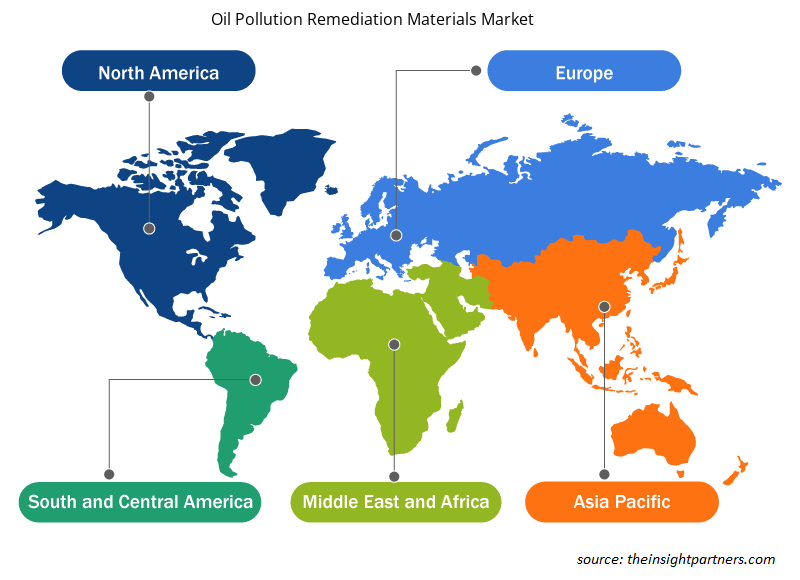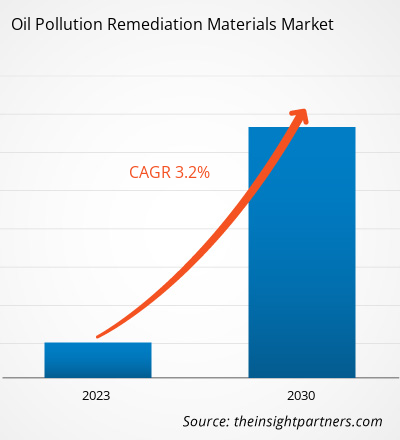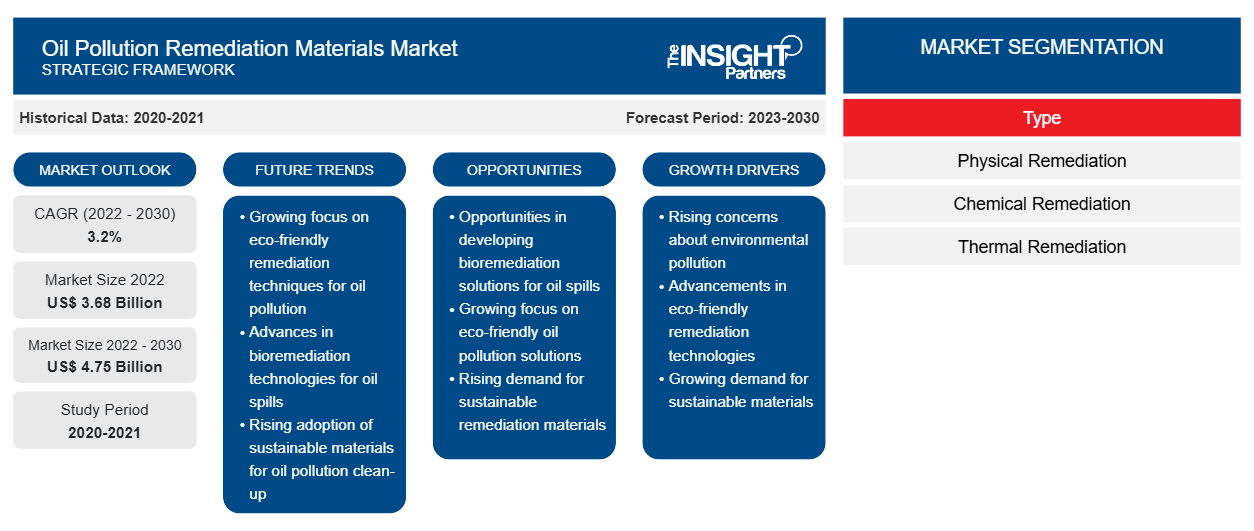[تقرير بحثي] تم تقييم سوق مواد معالجة التلوث النفطي بـ 3،684.36 مليون دولار أمريكي في عام 2022 ومن المتوقع أن يصل إلى 4،749.56 مليون دولار أمريكي بحلول عام 2030؛ ومن المتوقع أن يسجل معدل نمو سنوي مركب بنسبة 3.2٪ من عام 2022 إلى عام 2030.
تحليل السوق
تُستخدم مواد معالجة التلوث النفطي للحد من المخاطر العالية لتلوث المسطحات المائية بسبب أنشطة التنقيب عن النفط والنقل والأنشطة الصناعية المختلفة التي تجري في جميع أنحاء العالم. يتم تصنيف تقنيات المعالجة بشكل رئيسي إلى المعالجة الفيزيائية والمعالجة الكيميائية والمعالجة الحرارية والمعالجة البيولوجية . تعتبر مهمة للغاية لمعالجة مشاكل الانسكابات النفطية البحرية. تتكون المعالجة الفيزيائية من مواد مثل الرافعات والمزلقات والمواد الماصة. تشمل مواد المعالجة الكيميائية المشتتات والمواد الصلبة .
العوامل الرئيسية التي تدفع نمو سوق مواد معالجة التلوث النفطي هي أنشطة التنقيب عن النفط ونقله في الخارج المتزايدة واللوائح الحكومية المتعلقة بالاستعداد والاستجابة للانسكابات النفطية. في السنوات القليلة الماضية، صممت حكومات مختلف البلدان لوائح تنظيف الانسكابات النفطية لضمان استجابة سريعة وفعالة لحالات الطوارئ البيئية. تحدد هذه اللوائح عادةً الإجراءات والتقنيات والمعايير التي يجب على الشركات اتباعها لاحتواء الانسكابات النفطية والسيطرة عليها وتنظيفها. غالبًا ما تنص اللوائح على نوع مواد المعالجة التي يجب استخدامها لتقليل التأثير البيئي وضمان التنظيف الفعال. إن الحاجة المتزايدة إلى تنظيف فعال للانسكابات النفطية تدفع الطلب على مواد المعالجة.
مع تكثيف المخاوف واللوائح البيئية، هناك تركيز متزايد على استخدام مواد متقدمة وصديقة للبيئة للإصلاح. قد يتم إلزام بعض المواد الماصة والمشتتات والحواجز بالوفاء بمعايير السلامة والفعالية، مما يعزز استخدام المواد الصديقة للبيئة والفعالة في جهود الاستجابة للانسكاب النفطي. لدى الحكومات وصناعة النفط خطط استعداد لإجراء استجابة منتظمة للانسكاب النفطي. أدت تفويضات الحكومة بمعالجة الانسكابات النفطية على الفور وتقليل التأثير البيئي إلى زيادة الطلب على المواد الماصة والمشتتات ومواد الإصلاح الأخرى. في عام 2023، عززت وكالة حماية البيئة الأمريكية المعايير لتحسين استجابات الانسكابات النفطية في المياه الأمريكية والشواطئ المجاورة بموجب خطة الطوارئ الوطنية للحكومة الفيدرالية ( NCP ). تتضمن المعايير تطوير منتجات فعالة لإصلاح الانسكابات النفطية، مثل العوامل الكيميائية والبيولوجية، وتوفير الشفافية والمعلومات المتعلقة باستخدام هذه المنتجات.
إن زيادة أنشطة الاستكشاف والحفر البحرية، ونقل النفط عبر خطوط الأنابيب أو الناقلات، والأخطاء البشرية أثناء استخراج النفط وتخزينه، كلها عوامل تزيد من احتمالات وقوع حوادث تسرب النفط. ووفقًا لوكالة الطاقة الدولية، انتعش الطلب العالمي على النفط في عام 2021، ومن المتوقع أن تمثل آسيا 77٪ من الطلب على النفط بحلول عام 2025. ومن المتوقع أن تتجاوز متطلبات استيراد النفط في آسيا 31 مليون برميل يوميًا بحلول عام 2025. وقد بدأت حكومات دول مختلفة في منطقة آسيا والمحيط الهادئ مشاريع نفطية لتلبية الطلب المتزايد على النفط في المنطقة. في عام 2023، أعلنت شركة بتروناس ومقاولو الترتيبات البترولية التابعة لها عن 19 اكتشافًا للتنقيب عن النفط والغاز ونجاحين في تقييم الاستكشاف، مما ساهم في أكثر من مليار برميل من المكافئ النفطي من الموارد الجديدة لماليزيا. وهذا نتيجة لبرنامج استكشاف مكثف تم تنفيذه في السنوات القليلة الماضية، والذي شهد حفر 25 بئرًا. ومنذ عام 2015، يعد هذا أعلى عدد من آبار الاستكشاف التي تم حفرها في عام واحد.
محركات النمو والتحديات
وفقًا لتقرير صادر عن إدارة معلومات الطاقة الأمريكية في يناير 2024، زاد إنتاج النفط الخام منذ جائحة كوفيد-19 اعتبارًا من 9 يناير 2024، مما عكس انخفاضًا دام عامين. ارتفع إنتاج النفط الخام الأمريكي من 11.27 مليون برميل يوميًا في عام 2021 إلى 13.21 مليون برميل يوميًا في عام 2023 ومن المتوقع أن يصل إلى 13.44 مليون برميل يوميًا بحلول عام 2024. وفقًا لهيئة تنظيم الطاقة الكندية، يتم شحن معظم النفط الخام المنتج في كندا باستخدام خطوط الأنابيب من المقاطعات الغربية إلى المصافي في الولايات المتحدة وأونتاريو وكيبيك. وفقًا للتقرير الذي نشرته Bruegel AISBL في عام 2023، كانت روسيا من بين أكبر خمسة منتجين ومستهلكين للطاقة في جميع أنحاء العالم في عام 2021. خلال نفس العام، أنتجت 595.2 مليون طن متري من النفط الخام، تم تصدير 286.6 مليون طن متري منها. وهكذا، فإن أنشطة التنقيب عن النفط البحري ونقله المتزايدة هي المحرك لسوق مواد معالجة التلوث النفطي.
قم بتخصيص هذا التقرير ليناسب متطلباتك
ستحصل على تخصيص لأي تقرير - مجانًا - بما في ذلك أجزاء من هذا التقرير، أو تحليل على مستوى الدولة، وحزمة بيانات Excel، بالإضافة إلى الاستفادة من العروض والخصومات الرائعة للشركات الناشئة والجامعات
-
احصل على أهم اتجاهات السوق الرئيسية لهذا التقرير.ستتضمن هذه العينة المجانية تحليلاً للبيانات، بدءًا من اتجاهات السوق وحتى التقديرات والتوقعات.
رؤى إقليمية حول سوق مواد معالجة التلوث النفطي
لقد قام المحللون في Insight Partners بشرح الاتجاهات والعوامل الإقليمية المؤثرة على سوق مواد معالجة التلوث النفطي طوال فترة التوقعات بشكل شامل. يناقش هذا القسم أيضًا قطاعات سوق مواد معالجة التلوث النفطي والجغرافيا في جميع أنحاء أمريكا الشمالية وأوروبا ومنطقة آسيا والمحيط الهادئ والشرق الأوسط وأفريقيا وأمريكا الجنوبية والوسطى.

- احصل على البيانات الإقليمية المحددة لسوق مواد معالجة التلوث النفطي
نطاق تقرير سوق مواد معالجة التلوث النفطي
| سمة التقرير | تفاصيل |
|---|---|
| حجم السوق في عام 2022 | 3.68 مليار دولار أمريكي |
| حجم السوق بحلول عام 2030 | 4.75 مليار دولار أمريكي |
| معدل النمو السنوي المركب العالمي (2022 - 2030) | 3.2% |
| البيانات التاريخية | 2020-2021 |
| فترة التنبؤ | 2023-2030 |
| القطاعات المغطاة |
حسب النوع
|
| المناطق والدول المغطاة |
أمريكا الشمالية
|
| قادة السوق وملفات تعريف الشركات الرئيسية |
|
كثافة اللاعبين في سوق مواد معالجة التلوث النفطي: فهم تأثيرها على ديناميكيات الأعمال
يشهد سوق مواد معالجة التلوث النفطي نموًا سريعًا، مدفوعًا بالطلب المتزايد من المستخدم النهائي بسبب عوامل مثل تفضيلات المستهلكين المتطورة والتقدم التكنولوجي والوعي المتزايد بفوائد المنتج. ومع ارتفاع الطلب، تعمل الشركات على توسيع عروضها والابتكار لتلبية احتياجات المستهلكين والاستفادة من الاتجاهات الناشئة، مما يؤدي إلى زيادة نمو السوق.
تشير كثافة اللاعبين في السوق إلى توزيع الشركات أو المؤسسات العاملة في سوق أو صناعة معينة. وهي تشير إلى عدد المنافسين (اللاعبين في السوق) الموجودين في مساحة سوق معينة نسبة إلى حجمها أو قيمتها السوقية الإجمالية.
الشركات الرئيسية العاملة في سوق مواد معالجة التلوث النفطي هي:
- سارفا بيو ريميد ذ.م.م
- شركة تقنيات النفط المحدودة
إخلاء المسؤولية : الشركات المذكورة أعلاه ليست مرتبة بأي ترتيب معين.

- احصل على نظرة عامة على أهم اللاعبين الرئيسيين في سوق مواد معالجة التلوث النفطي
المنافسة والشركات الرئيسية
تعد Sarva Bio Remed LLC وOil Technics Ltd وAnsell Ltd وOil-Dri Corp of America وVerde Environmental Group Ltd وEcolab Inc وCosco Shipping Heavy Industry Co Ltd وRegenesis وTOLSA SA وCL Solutions LLC من بين اللاعبين البارزين الذين تم عرضهم في تقرير سوق مواد معالجة التلوث النفطي. بالإضافة إلى ذلك، تمت دراسة العديد من اللاعبين الآخرين وتحليلهم أثناء الدراسة للحصول على رؤية شاملة للسوق ونظامه البيئي. يتضمن تقرير سوق مواد معالجة التلوث النفطي أيضًا وضع الشركة وتركيزها لتقييم أداء المنافسين/اللاعبين في السوق.
تطورات الصناعة والفرص المستقبلية
وترد أدناه المبادرات التي اتخذها اللاعبون الرئيسيون العاملون في سوق مواد معالجة التلوث النفطي:
في نوفمبر 2022، استثمرت شركة Ansell Ltd حوالي 80 مليون دولار أمريكي في مصنع التصنيع الجديد في الهند.
- التحليل التاريخي (سنتان)، سنة الأساس، التوقعات (7 سنوات) مع معدل النمو السنوي المركب
- تحليل PEST و SWOT
- حجم السوق والقيمة / الحجم - عالمي، إقليمي، بلد
- الصناعة والمنافسة
- مجموعة بيانات إكسل
التقارير الحديثة
تقارير ذات صلة
شهادات العملاء
سبب الشراء
- اتخاذ قرارات مدروسة
- فهم ديناميكيات السوق
- تحليل المنافسة
- رؤى العملاء
- توقعات السوق
- تخفيف المخاطر
- التخطيط الاستراتيجي
- مبررات الاستثمار
- تحديد الأسواق الناشئة
- تحسين استراتيجيات التسويق
- تعزيز الكفاءة التشغيلية
- مواكبة التوجهات التنظيمية























 احصل على عينة مجانية ل - سوق مواد معالجة التلوث النفطي
احصل على عينة مجانية ل - سوق مواد معالجة التلوث النفطي